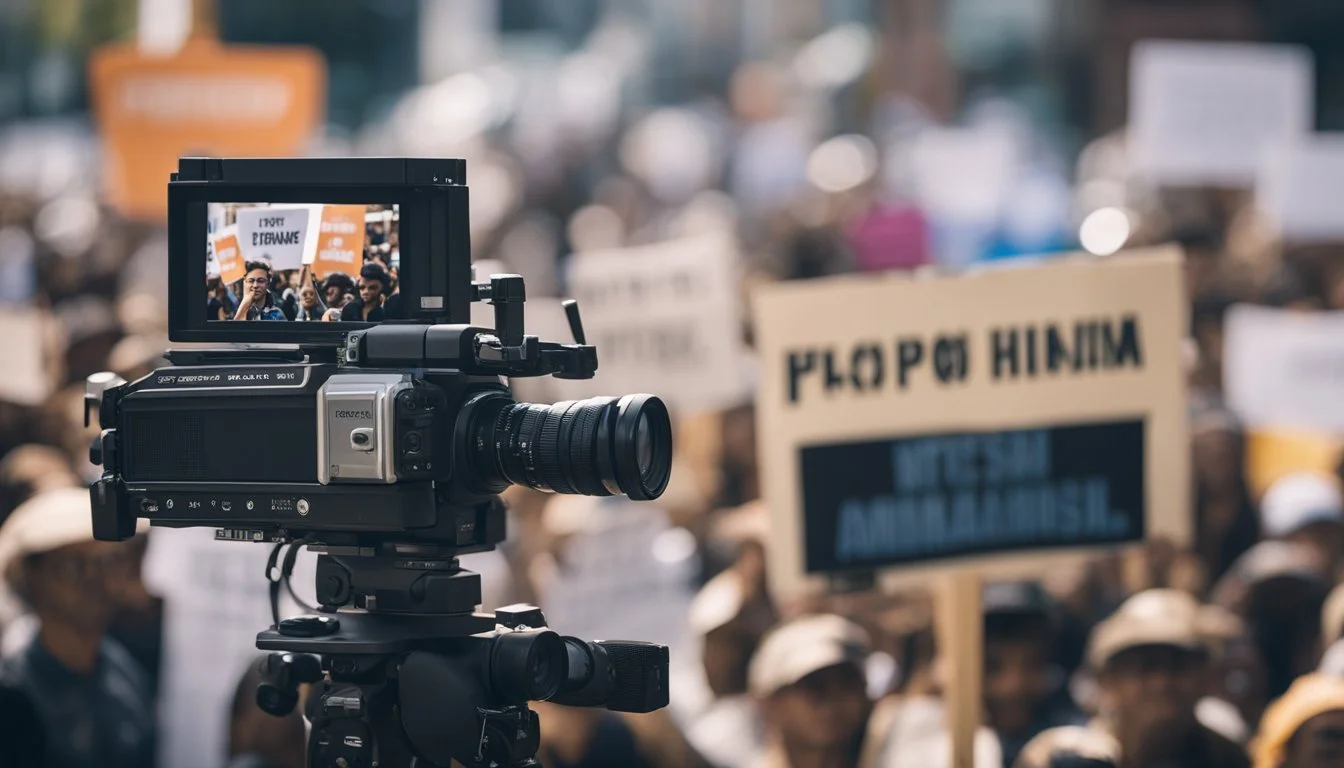Exploring the Intersection of Filmmaking and Social Activism
A Powerful Medium for Change
The intersection of filmmaking and social activism provides a powerful platform for change, blending artistic expression with the pursuit of justice. When filmmakers like Matthew Soloman use their craft to spotlight issues such as systemic racism and community engagement, they raise awareness and inspire collective action.
Sociologists and scholars have studied how documentary films inspire activism, showing the unique role these films play in disseminating new social movement agendas. Events like the conversation between Dolores Huerta and Eva Longoria highlight how the film industry can amplify voices and bring critical social issues to the forefront.
By leveraging the emotional impact and wide reach of film, activists can effectively mobilize support and drive societal progress. The stories and truths captured on camera resonate deeply, urging viewers to reflect and, importantly, to act.
Historical Context of Filmmaking and Social Activism
The convergence of filmmaking and social activism has a rich history that highlights the evolution of activist cinema and showcases milestone films that have driven social movements. These intersections convey how artistic expressions inform public consciousness and inspire change.
Evolution of Activist Cinema
Early examples of activist cinema emerged in the early 20th century, focusing on labor rights and social injustices. Films like "The Birth of a Nation" (1915), though controversial, spurred political responses that led to the creation of counter-narrative films such as "Within Our Gates" (1920) by Oscar Micheaux.
The 1960s and 1970s marked a significant period with the rise of the Civil Rights Movement. Directors like Spike Lee used the medium to spotlight racial inequality, exemplified by "Do the Right Thing" (1989). The period also saw the birth of the documentary as an essential tool for activism, with works like "Salesman" (1969) highlighting social issues in a raw, unfiltered manner.
In recent decades, digital technology has democratized filmmaking. Activists now produce and share documentary films globally, using platforms like YouTube and Vimeo. This evolution has amplified voices from diverse backgrounds and enabled rapid responses to social issues.
Milestone Films in Activist Movements
"The Battle of Algiers" (1966) provides a gripping portrayal of the Algerian struggle for independence from French colonial rule. Its realistic, newsreel style had a profound impact on audiences and inspired political discourse worldwide.
Another milestone, "Harlan County, USA" (1976), directed by Barbara Kopple, documents coal miners' strikes in Kentucky. The film's raw depiction of labor strife won an Academy Award and spotlighted the harsh realities of working-class America, pushing labor conditions into the public consciousness.
More contemporary examples include "An Inconvenient Truth" (2006), which brought climate change to the forefront of global debates. This film's impact is evident in the heightened awareness and policy discussions surrounding environmental issues.
These milestone films illustrate how cinema transcends entertainment, serving as a powerful vehicle for social change and advocacy.
The Role of Filmmakers as Social Activists
Filmmakers have increasingly taken on roles as social activists, using their platforms to raise awareness and inspire change. This section explores the notable individuals and impactful documentaries that have influenced public opinion and societal norms.
Influential Activist Filmmakers
Activist filmmakers such as Stanley Nelson have made significant contributions to social justice. Nelson's work, like the documentary on the Blinding of Isaac Woodard, brings attention to systemic racism and police brutality. His films encourage discussions around civil rights and bring crucial issues into mainstream conversations.
Ava DuVernay is another prominent figure whose work addresses racial inequities. Her documentary, "13th," examines mass incarceration in the United States and its historical ties to slavery, shedding light on the injustices within the criminal justice system.
Documentaries that Changed Public Opinion
Certain documentaries have played crucial roles in shifting public perception and promoting social justice. For example, "Blackfish" sparked widespread outrage over the treatment of orcas in captivity, leading to policy changes at SeaWorld.
"The Cove" exposed the brutal dolphin hunting practices in Taiji, Japan, garnering international condemnation and pressure on local and international governments to address animal rights concerns.
"An Inconvenient Truth" by Al Gore raised awareness about climate change. Its impact was profound, significantly increasing public understanding and prompting actions towards environmental policy changes.
Strategies for Social Change through Film
Filmmakers use diverse strategies to effect social change, including narrative storytelling to advocate for causes and visual symbolism to convey powerful messages.
Narrative Storytelling as a Tool for Advocacy
Storytelling plays a crucial role in filmmaking aimed at social change. It allows audiences to connect emotionally with characters and situations. Through compelling narratives, filmmakers can highlight social issues such as inequality, climate change, and human rights.
In documentaries, real-life stories and events are depicted to shed light on pressing issues. For feature films, the use of relatable characters and dramatic arcs can raise awareness and even spark activism. Consistent, focused storytelling can foster empathy and understanding among audiences, prompting them to take action.
The Impact of Visual Symbolism
Visual symbolism serves as a potent tool in films advocating for social change. Imagery and symbols can communicate complex ideas succinctly and memorably. For example, the use of red to symbolize danger or revolution in a film can quickly convey critical thematic elements.
Documentaries often use visual metaphors to create connections between the viewers' emotions and the subject matter. Feature films might employ color schemes, lighting, and props to symbolize broader societal issues or injustices. These visual techniques enrich the narrative, enabling viewers to grasp the underlying messages and prompting deeper reflection on the issues presented.
Ethical Considerations in Activist Filmmaking
Ethical considerations in activist filmmaking are crucial, impacting both the artistic choices made by filmmakers and their obligations to the subjects and audiences they portray. The balance between creating compelling art and delivering a powerful social message must be thoughtfully managed.
Balancing Art and Message
Filmmakers often face the challenge of blending artistic expression with activism. The creative elements, such as narrative style, cinematography, and editing, must enhance the social message without overshadowing it.
A well-crafted film can highlight pressing social issues, but the artistry should serve the cause rather than detract from it. This balance ensures that the message remains clear and impactful, keeping viewers engaged while encouraging them to reflect and act.
This delicate balancing act requires a deep understanding of the issues at hand and a commitment to authenticity, avoiding sensationalism or misrepresentation. Intentional and thoughtful artistic choices foster deeper emotional connections with the audience, thus amplifying the film's social impact.
Responsibility to Subjects and Audiences
The responsibility to portray subjects and inform audiences ethically is central to activist filmmaking. Filmmakers must obtain informed consent from their subjects, ensuring they understand how they will be represented and the potential implications of their participation.
Respecting the dignity and privacy of individuals is paramount. Sensitive topics should be handled with care to avoid exploiting or sensationalizing personal stories. Transparent communication and maintaining the trust of participants are essential throughout the filmmaking process.
Filmmakers also owe their audiences honest and accurate portrayals. Misinformation or biased representations can undermine the credibility of the film and the movement it supports. Striving for accuracy, fairness, and comprehensive research ensures that the film serves as a reliable and powerful tool for advocacy.
Case Studies of Activist Filmmaking
Activist filmmaking has played a critical role in promoting social justice and awareness. This section delves into how grassroots movements and the marginalized benefit from activist cinema.
Grassroots Movements Depicted in Film
Documentary films have successfully highlighted grassroots movements by focusing on local struggles and issues. An example is "The Act of Killing," which tackles the dark history of Indonesia's anti-communist purge. It serves as a compelling narrative on how film can shed light on historically silenced events.
Another notable example is Ava DuVernay's "13th," which examines the intersection of race, justice, and mass incarceration in the United States. Such films often utilize interviews and archival footage to present compelling, authentic narratives that resonate with audiences.
Cinema as a Voice for the Marginalized
Films like "Born Into Brothels" have been poignant in giving a platform to marginalized communities. This documentary provides a raw look at the lives of children of sex workers in Kolkata, capturing their aspirations and adversities. Such works are instrumental in humanizing statistics and fostering empathy.
Another impactful film is "Paris Is Burning," which offers an intimate portrayal of New York City's drag ball culture. It draws attention to issues of race, class, and gender identity, emphasizing the importance of representation in media.
By providing a platform for marginalized voices, these films play a pivotal role in advocating for social change.
The Business of Activist Filmmaking
Effectively navigating the business of activist filmmaking involves overcoming funding and distribution obstacles while employing creative audience engagement strategies. Success requires balancing financial viability with social impact.
Funding and Distribution Challenges
Securing funding for activist films can be particularly difficult. These projects often rely on grants, crowdfunding, and donations due to limited commercial appeal and investor risk aversion. Nonprofit organizations and social justice foundations are critical sources of support.
Distribution channels focus on film festivals, streaming services, and community screenings rather than traditional theaters. Activist films may partner with grassroots movements to amplify reach. Filmmakers often leverage niche platforms and social media for broader access.
Examples of support include:
Sundance Institute Documentary Fund
Ford Foundation JustFilms initiative
Audience Engagement Strategies
Connecting with audiences requires multifaceted approaches. Activist filmmakers utilize social media campaigns to generate buzz and build communities around their films. Interactive websites and collaborative events foster deeper engagement.
Educational outreach is crucial. Partnering with schools and universities enhances film impact, as does hosting panel discussions and Q&A sessions with filmmakers and activists. Screenings followed by discussions encourage audience reflection and connection to the issues presented.
Effective methods include:
Live streaming discussions
Hashtag campaigns for broader social media interaction
Collaboration with influencers and community leaders to reach targeted demographics
Technological Advancements and Activist Filmmaking
Technological breakthroughs have significantly reshaped activist filmmaking. The advent of portable digital cameras and user-friendly editing software has democratized film production.
The Role of Social Media
Social media platforms amplify the reach of activist films. Tools on platforms like Twitter, Facebook, and Instagram enable real-time sharing and engagement.
Filmmakers leverage these tools to build communities and mobilize supporters swiftly. Social media campaigns often accompany film releases, fostering discussion and action.
This intersection of technology and activism creates a unique ecosystem where films not only inform but also catalyze change. Analytics from these platforms provide valuable insights, helping activists refine their strategies to maximize impact.
Measuring Impact: Success Beyond the Box Office
Understanding the true impact of documentary films on social activism extends beyond conventional metrics like ticket sales. This section delves into various methodologies used to measure social change and the long-term effects of activist films.
Quantifying Social Change
To measure social change attributed to documentary films, researchers employ both qualitative and quantitative methods. Surveys and interviews gather personal testimonials and behavioral shifts among viewers.
Case studies offer rich details on specific audiences' transformations. Metrics such as policy changes, community engagement, and social media interactions also highlight a film's influence. For instance, the PUMA Impact Award honors films that demonstrate substantial social impact, emphasizing changes in public discourse and awareness.
Mixed-method approaches combine statistical data and narrative accounts to provide a holistic view of a documentary's efficacy. Tools like social sentiment analysis further dissect how a film resonates across different demographics.
Long-Term Effects of Activist Films
Documentary films often have impacts that evolve over time.
Longitudinal studies track shifts in attitudes and behaviors long after the initial release, revealing ongoing influence. Films like "An Inconvenient Truth" continue to spur environmental activism years after their premieres.
Educational initiatives incorporated into school curricula can extend a film's reach and deepen its impact.
Additionally, community screenings and panel discussions further propagate the film's message, fostering ongoing dialogue and action. By integrating these extended strategies, filmmakers and activists can ensure their work remains relevant and influential over the long haul.
The Future of Filmmaking in Social Activism
Filmmaking continues to evolve, shaping and being shaped by social activism. Key developments are emerging voices from diverse backgrounds and predictive trends that indicate the transformative potential of this synergy.
Emerging Voices in Activist Filmmaking
New filmmakers bring fresh perspectives to the social activism landscape. Individuals from underrepresented communities are increasingly using documentary filmmaking as a platform to amplify their voices. These emerging voices often highlight issues like racial inequality, LGBTQ+ rights, and environmental justice.
Organizations and collectives are also actively providing resources and training to these new activists. Initiatives such as film grants, workshops, and mentorship programs play a crucial role. As a result, the diversity in storytelling is expanding, offering nuanced views on complex social issues. This democratization of filmmaking ensures more stories are told authentically by those directly affected.
Predicting Trends and Potential
Technological advancements and changing social dynamics are shaping the future of activist filmmaking. The rise of virtual reality (VR) and augmented reality (AR) offers immersive experiences, making it possible to engage audiences more deeply. Filmmakers are exploring these tools to create more visceral and impactful narratives.
Social media platforms continue to be vital for dissemination, allowing films to reach global audiences instantaneously. Crowdfunding is becoming a popular method for financing projects, breaking the dependency on traditional funding sources.
The convergence of these trends suggests that activist filmmakers will have more avenues to innovate and connect with audiences. This proliferation of accessible technology and platforms bodes well for the future, empowering filmmakers and amplifying the reach and impact of their work.





